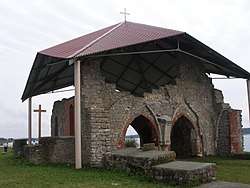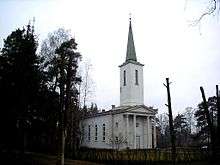Ikšķile
Ikšķile (![]()
Ikšķile | |
|---|---|
Town | |
 | |
 Flag  Coat of arms | |
 Ikšķile Location in Latvia | |
| Coordinates: 56°49′N 24°29′E | |
| Country | |
| District | Ikskile District |
| Town rights | 1992 |
| Government | |
| • Mayor | Indulis Trapiņš |
| Area | |
| • Total | 8.73 km2 (3.37 sq mi) |
| Elevation | 20 m (70 ft) |
| Population (2020) | |
| • Total | 7,270 |
| • Density | 830/km2 (2,200/sq mi) |
| Time zone | UTC+2 (EET) |
| • Summer (DST) | UTC+3 (EEST) |
| Postal code | LV-5052 |
| Calling code | +371 650 |
| Number of city council members | 15 |
| Website | www |
The Livonian word Ikšķile (or the German Uexküll) denotes "the ford or islet(s), i.e. a place (on the Daugava River) where it was possible to cross the river, belonging to the son of the nobleman Ike”. The personal name Ike has the honourable meaning ‘age, lifetime’. The Ike family had a great power in Livonia. They controlled the military and trade traffic across the Daugava at Ykescola/Ykescole.[1]
Other sources tell that the word Ikšķile (or the German Üxküll, Uexküll) comes from the meaning of (Finno-ugrian) Livonian word ükskül (yksikylä in Finnish). Ükskül (üks = one, kül = village) means simply just village number one, one village or The Village. [2]
History
Ikšķile is one of the oldest inhabited regions of Latvia. This is evidenced by the mound and an ancient burial ground in the present rural area of Ikšķile. By the 9th - 12th centuries there was already a Liv village on the Daugava waterway. In 1185 Gotland's stone-mounds built the castle of Ikšķile with a chapel or church. In 1186 the upper bishop of Bremen appointed the monk Meinard, of Segeberga monastery, near Lübeck, as the first bishop of Ikšķile. Under his leadership Ikšķile became the center from which Catholicism would spread in Latvia. Both Meinard and the second bishop, Bertolt, were buried inside Ikšķile Church (Bishop Meinard was later reburied at the Dome Church in Riga). In 1201, the third Bishop of Ikšķile, Albert, moved the Livonian Bishopric Center to Riga. During the Livonian Crusade Ikšķile Castle was attacked by the Semigallian troops on the left bank of the Daugava several times, and in 1203 and 1206 Prince Vladimir of Polotsk tried to capture the castle.

In 1638 the municipality of Ikšķile included eight manors, the richest of which being the Ikšķile and Tīnūžu manors. By the 19th century there were two manors left in the Ikšķile municipality, the Ikšķile and Berkava manors. After the formation of Ogre, which originally belonged to the Ikšķile municipality, the area of Ikšķile parish was gradually reduced.
The castle of Ikšķile was destroyed in the 17th century, and the church (which was rebuilt many times) was destroyed in 1916 by German artillery. In 1933 a new Lutheran church was erected near Ikšķile, near the station. Due to the construction of the Riga Hydroelectric Power Plant and the reservoir, the ruins of the first stone church were preserved in the 1970s; the island on which they are now located was increased and strengthened. The ruins of Ikšķile manor, as well as a castle, are below the water of the reservoir.
Government
The head of the city government in Ikšķile is the mayor. The incumbent mayor Indulis Trapiņš.[3]
Ikšķiles government is located at Ikšķile, Peldu street 22.
School
Ikšķile Secondary School is a Latvian State School, founded in 1966. It is also a Junior Achievement Latvia School.
The origins of the Ikšķile School date back to 1864, when the first parish school was established under the leadership of Ikšķile. The school building is named Zemturi. About a hundred years after the development of Ikšķile School it was decided to build a new school. The building of the school took place near the center of Ikšķile, next to the new A6 highway. The Ikšķile School of the Ogre District was opened in 1966. The development and growth continued, therefore additional schools were built, enabling the establishment of a secondary school. From 1989 to 1990, the school was rebuilt, and in 1990 it was named the Ikšķile Secondary School.
Ikšķile library
Ikšķile District Central Library is a library in Ikšķile, located on Peldu street 22.
The first library in the vicinity of Ikšķiles was formed and operational by the beginning of the 19th century. The first written information about the library of Ikšķile region can be found at the beginning of V. Villeruš's book "Gājums", which states that in 1852 a Reading Association with 35 members was established in the Ikšķile municipality. The library was restored in 1946, after the Second World War. There have been changes to the library over the years; in 1974, a separate children's library was created.
Popular places and objects
- Ruins of the Ikšķile Church - the ruins of the oldest stone building in Latvia, located on a small islet, Sv. Meinard Island, artificially created in the Riga hydroelectric power station reservoir. Ikšķile Church was built in 1185 under the direction of Bishop Meinard. Rebuilt in 1879 - 1881, destroyed in 1916. After the flood of the Riga Hydroelectric Power Plant in the 1970s it has been surrounded by the reservoir waters. Today the ruins are preserved; a roof over them has been built, and the island is secured. Once a year, when the water level in the reservoir is lowered, it is possible to go to the church ruins on foot along the former road, which is lined by old tree trunks that have remained.
- Ikšķile Lutheran Church - Ikšķile, Kalēju street 1. Built in 1931 - 1933 by the architect Kundziņš. During the Soviet era, the church was used as a bookstore for the State Library of Latvia.
- Memorial stone - opposite the ruins of the old Ikšķile Church. The stone with the name "Ikšķile" in the Latvian, Liv, and German languages was installed in 1988.
- Ikšķile Spiritual Orthodox Church - Orthodox graves. Built in 1936.
- Artist J. Kuga's dwelling house - Ikšķile, J.Kugas street 11. In this house lived a Latvian artist and stage designer, LMA professor Janis Kuga (1868 Ikšķile Parish - 1969 Toronto, Canada). J. Kuga is the founder of stage painting in Latvia. The house is an architectural monument of local significance, and it is planned to arrange a museum inside of the building.
- Ikšķile Lutheran Cemetery - Ikšķile, Klusajā street. Inside the cemetery there is a monument dedicated to the Latvian riflemen who were killed in the First World War, installed in 1926, and two gravestones that are national monuments of art.
- Kapāmuru Brothers' Cemetery - Place of burial of the fallen Russian and German soldiers in the World War I in 1968. The monument was made by sculptor J. Karlova.
- Liepāderu brothers' cemetery - The soldiers who died in the Jugla battle of 1917 are buried here.
- Turbu grandstand - The girder's trunk circumference is over 7.1 m.
- Relziķu oak - trunk circumference 5.3 m.
- Kranciema juniper - trunk circumference 1 m.
- Ikšķiles open air stage - Cultural-historical place. Monument status from 2008.
See also
- List of cities in Latvia
References
Source: William Urban, The Teutonic Knights, a Military History, (London 2003) 82,83. ISBN 1-85367-535-0
- Urmas Sutrop (2003). "Ykescola ~ Ykescole attested in the Chronicle of Henry of Livonia and Üksküla (Uexküll). To Tõnu Karma on his 80th birthday". Estonian Mother Tongue Society Year Book. 49.
- Latvijas Centrs Ikšķile
- ikskile.com (2015-04-29). "Ikšķiles novada mērs (vienotība) Indulis Trapiņš izsludina maksātnespēju | IKSKILE.COM". IKSKILE.COM (in Latvian). Retrieved 2018-06-19.
External links
- Ikšķile County - Official website
- Ikskile.com - Portal for Ikšķile region, inhabitants' resource
- Vietas.lv - Ikšķile in the guide of Latvia
- Iedzivotaji.lv - Ikšķile County Citizens' Association IEDZIVOTAJI